.jpg?width=1000&height=750&name=ralway-communication-images%20(3).jpg)
The communications industry has been continuously going through disruptive changes. Gone are the days when wire-based communication systems ruled the industry. Within no time, the revolutionary introduction of wireless communications in 2G/3G has given way to futuristic 5G based communication systems. To remain relevant, all industries globally are transiting to new technologies. Railway communication systems too are undergoing a paradigm shift. Global System for Mobile Communications for Railways, once a lifeline, is approaching extinction and will be completely taken over by 2030, by 5G based Future Railway Mobile Communication System (FRMCS) designed by UIC, in close cooperation with the different stakeholders from the rail sector.
GSM-R is the current technology the railway industry uses for its radio mobile communications. It is an MOTS (modified offthe-shelf technology) system, based around commercial 2G based GSM (Global System for Mobile Communications) offerings for handheld mobiles but enhanced to deliver the specific “R” (railway) functionality. Introduced in the late 1990s, its specifications were developed by the Union Internationale des Chemins de Fer (UIC), commonly known as the International Union of Railways. GSM-R is proven reliable and secure besides being a highly effective enabler of convergence, efficiency, and interoperability in Europe and elsewhere, with nearly 150,000 km of lines in Europe and 250,000 km of lines in the rest of the world. While GSM-R is approaching the end of life around 2030, it is still a dependable system not only in Europe but also in many other parts of the world.
.jpg)
GSM-R uses a combination of wireless and wired infrastructure to provide voice and data communication between train drivers, dispatchers, and other railway staff. It uses a specific frequency band of around 800/900 MHz (Figure 1). In addition, the frequency bands 873-876 MHz (uplink) and 918- 921 MHz (downlink) are used as extension bands under the name Extended GSM-R (E-GSM-R).
GSM-R is a Time-Division Multiple Access (TDMA) system that uses Gaussian Minimum-Shift Keying modulation (GMSK). It is typically implemented using dedicated base stations (BSs) close to the rail track. The distance between two neighboring BSs is 7–15 km. Some critical parameters of GSM-R systems viz-a-viz 5G based communication systems are summarized in Table 1.

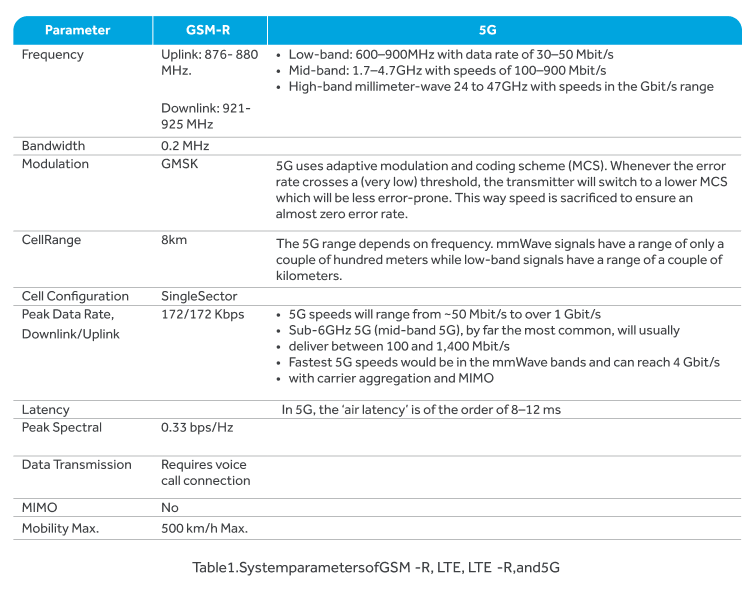
The GSM-R’s architecture is divided into the Base Station Subsystem (BSS), Network Switching Subsystem (NSS), and Operational Support System (OSS), depicted in Figure 2 below. The user can be reached by means of functional numbering and location-dependent addressing (LDA).
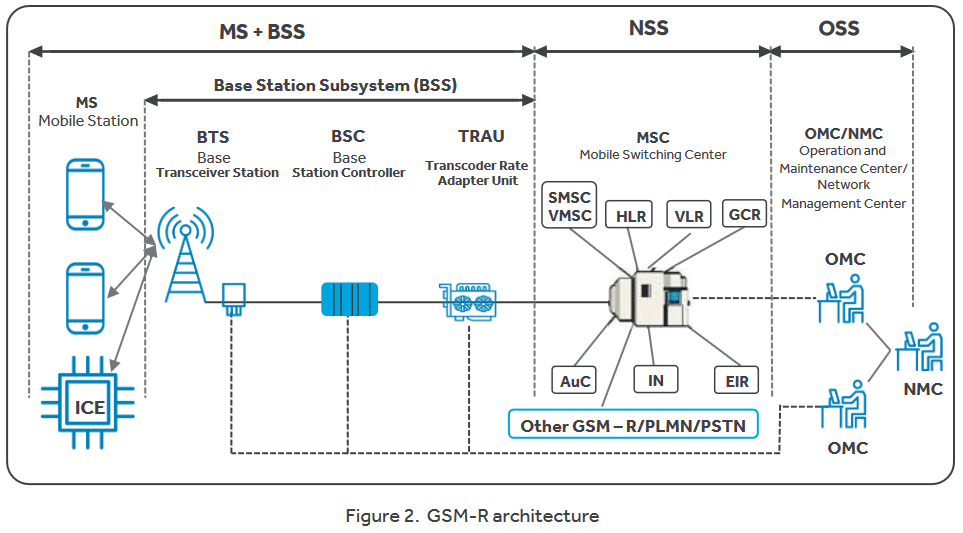
.jpg)
GSM-R supports both voice and data transmission. The network serves as a data carrier for the European Train Control System (ETCS) based signaling system used for railway control. ETCS has three levels of operation and uses the GSM-R radio network to send and receive information from trains. On the first level (ETCS-1), GSM-R is used only for voice communications. On the second and third levels (ETCS-2 and ETCS-3), GSM-R is used mainly for data transmission. GSM-R is especially relevant to ETCS-2 and ETCS-3, where the train travels at a speed of up to 350 km/h and it is necessary to guarantee continuous supervision of train position and speed. When the call is lost, the train must automatically reduce the speed to 300 km/h (ETCS-1) or lower. Various communication services provided by GSM-R are as below:-
| Sl. No. | Communication Type | Description |
|---|---|---|
| (i) | Point to Point (P2P) Call | Allows user to make a distinct call |
| (ii) | Voice Broadcast Call | Allows groups of users to receive common information |
| (iii) | Voice Group Call | Allows groups of users to make calls within/among the groups |
| (iv) | Emergency Call | Allows user to call controller by a short code or button during emergencies |
| (v) | Functional Addressing | Allows a user or an application to be reached by a number which identifies the relevant function and not the physical terminal |
| (vi) | Location dependent addressing | Provides the routing of mobile originated calls to the correct controller e.g. relative to the geographic area |
| (vii) | eMLPP (enhanced Multi-Level Precedence and Preemption) | Allows resource preemption for priority calls |
.jpg)
While the assigned radio frequencies for GSM-R limit its capacity, increasing interference from public networks is further hampering the use of GSM-R. These limitations include:
The interference between GSM-R and other public networks increases as both railway and public operators desire good coverage along the rail tracks. Instead of cooperating in network planning, railway and public operators fight for the coverage. This could result in severe impairment of voice and data communications as well as network loss over several hundred meters of track. Theoretically, such interference can be avoided if public operators do not use frequency bands adjacent to those of GSM-R for the areas close to rail tracks; however, this is not well implemented in practice. In future, interference may increase owing to the growth of GSM-R network deployment and the potential growth of public networks.
As a narrowband system, GSM-R cannot provide advanced services and adapt to new requirements. The maximum transmission rate of GSM-R per connection is 9.6 kbit/s, which is sufficient only for applications with low demand; message delay is in the range of 400 ms, which is too high to support any real-time application and emergency communication. Future new services such as real-time monitoring require a wideband system to have a larger data rate and short delay.
GSM-R’s 4 MHz bandwidth can support 19 channels of 200 KHz width. This is sufficient for voice communication, as voice calls are limited in time and do not occupy resources continuously. However, the current capacity is insufficient for the next-generation railway system, where each train needs to establish a continuous data connection with a Radio Block Center (RBC), and each RBC connection needs to constantly occupy a one-time slot. The radio capacity can be increased by using more spectrum resources.
Despite the above shortcomings, GSM-R has been a great success worldwide with more than 100,000 Km of railway tracks operated every day in Europe alone. Nevertheless, while the needs of the railways are constantly evolving in terms of capacity, latency, and safety, the evolution of railways telecom standards remain dependent on the evolution cycles of the commercial telecom industry with an end of support for GSM-R planned by 2030. These considerations led UIC to launch the first studies for a successor to GSM-R by 2012, named FRMCS. The new set of User Requirements Specifications (URS) focused mainly on rail communication needs as a basis for the development of the GSM-R successor.
5G was originally designed to support high mobility services requiring high reliability and low latency which are in alignment with the performance requirements of railway communications defined by the UIC. Railway applications relying on critical data communications have latency requirements below 10 ms. The 5G New Radio (NR) features that support low and bounded latency can enable such use cases. While operators will benefit from the low latency and high bandwidth of the new spectrum available for rail, the passengers will benefit from a much higher quality of rail services.
Thus, with 5G NR as its critical enabler, FRMCS is set to become the global standard for railway communications. This mobile broadband-ready technology will not only help improve operational efficiency but also accelerate digital transformation leading to improved safety and support for innovative passenger services. Some of the advantages of 5G based FRMCS include:
.jpg)
(a) Ubiquitous connectivity to keep railway passengers connected at all times. This will improve infotainment services such as multimedia passenger information systems and streaming services tremendously.
(b) Downloadable app to allow passengers to use apps that integrate on-board video content, providing real-time situational awareness. For example, real-time video of train station locations or rail carriage occupation levels.
(c) Enhanced safety and reliability of services to commuters and freight operators at reduced cost and better security, including:
(i) Automatic train operations supported by automation and sensor communications. Sensors will be deployed for monitoring tracks, rolling stock, power systems, and environmental conditions. 5G will enable all this data to be connected in real time.
(ii) When combined with software analytics and machine learning, 5G will enable railway operators to carry out preventive maintenance, predict failures, and anticipate floods and other events that could interrupt services.
(iii) Higher bandwidth of 5G will allow much greater usage of high-quality video for security, communications between operational personnel, improved situational awareness during emergency events, drone inspections, and a host of other applications that generate video and/or high amounts of data.
(iv) Using IoT data to predict maintenance requirements will increase the availability and productivity of rail assets. It will facilitate higher standards of protection from cybersecurity attacks and physical threats.
(v) 5G will enable analytics that identify potential incidents at rail crossings before they happen.
.jpg)
Being 2G-based (voice and SMS), GSM-R is not bandwidth-efficient. 5G, on the other hand, is a better option to replace GSM-R in the future. It offers multiple advantages over GSM, being best suited for data communications besides efficient network architecture, highly reduced packet delays (crucial for ETCS messages), and high throughput radio access due increased spectral efficiency through advanced multiplexing and modulation.
The predicted obsolescence of GSM-R is by 2030, while the life expectancy of ETCS is 2050. UIC is, therefore, laying the foundations of the FRMCS with the following goals:
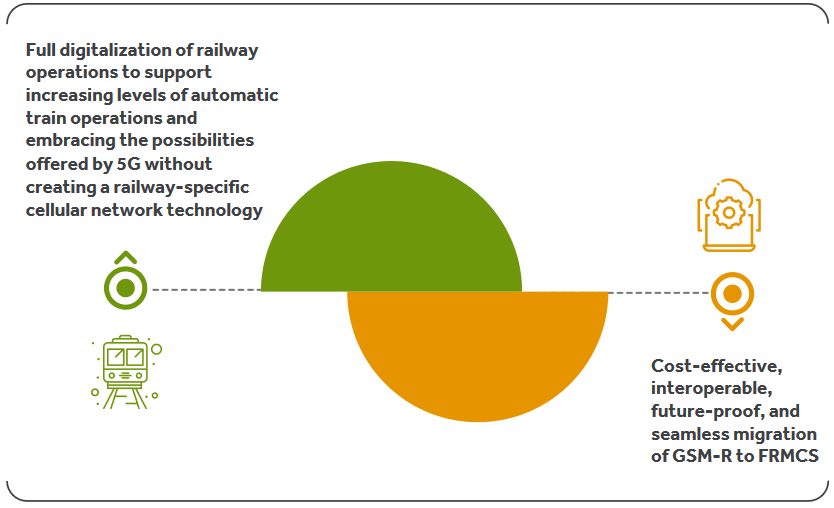
Hence, UIC has been working on defining a FRMCS as part of 3GPP Release 16 standards to support automatic train operations, virtual coupling, tele maintenance, etc. Both GSM-R and FRMCS systems will coexist for a considerable period, where both communication services will be used.
The new FRMCS/5G system will need to work in parallel with GSM-R for gradual migration. This phased transition requires a deep understanding of both GSM-R and the new FRMCS systems to ensure continued smooth operations through the following challenges:
Spectrum availability
GSM-R is currently deployed in the 900 MHz band (R-GSM band) and its extension band (ER-GSM band). Either additional spectrum will be needed for FRMCS or some part of the GSM-R spectrum may need to be deployed for it. Towards this, the Electronic Communications Committee (ECC) in Europe has approved paired frequency bands 874.4–880.0 MHz and 919.4–925.0 MHz, and the unpaired frequency band 1900–1910 MHz for railway mobile radio to include both GSMR and FRMCS. Thus, in addition to the independent operation of FRMCS in the 1900 MHz band, FRMCS and GSM-R can coexist in the 900 MHz band until the GSM-R operation is phased out.
Vast variety of on-board systems
The technologies deployed will be pure GSM-R, pure FRMCS/5G, and a mixture of both. All ofthe above need to be supported and will necessitate reusing a significant part of GSM-R systems in the 5G world.
Need for skilled resource bank
This implies mandatory technical capability in terms of experienced resources who intimately know both GSM-R and FRMCS/5G to run both networks in parallel. This needs proactive planning and execution.
The European Union mandate for 5G road and rail corridors
The European Union has planned to provide 1 GB per second throughput per train for passenger connectivity. This, along with some video applications of FRMCS, far exceeds the throughput capabilities possible within the 1900 MHz spectrum. Hence, there is a need to combine Communications Service Provider (CSP) networks in conjunction with FRMCS, either as primary or complementary access. In primary access, CSPs can offer both critical and noncritical network slices for safety-critical use cases and passenger connectivity. Therefore, 5G network deployments should happen on a 1900 MHz dedicated spectrum and/or spectrum owned by CSPs which will serve as an overlay network to GSM-R operating on the 900MHz band. This will ease the migration of railway communications systems from GSM-R to FRMCS.
As FRMCS is to permit the co-existence of both systems during migration, it must be bearer-independent, implying clear separation between the communications layer and the application layer, allowing simultaneous use of 4G/5G, private/public, and Wi-Fi or other technology with mobility, without service interruption.
The FRMCS architecture has a three-layer design (Figure 3) with clear separation in the following:
(a) Application Layer (Railway Application Stratum): This provides railway-specific functionalities using services offered by the service stratum.
(b) Service Layer (Service Stratum): This includes functionalities such as identity and role management, security features, service session management, and group communication services. It comprises Communications Services and Complementary Services. While Communications services enable the exchange of information between two or more service users, Complementary services are ancillary services, e.g., providing and/or utilizing the location of the service user, supporting communications services, and the railway application stratum. Service stratum functionality is envisioned to be implemented via the Mission Critical Services (MCX) framework on top of the 5G system specified by 3GPP.
(c) Transport Layer (Transport Stratum): This comprises the set of access and corresponding core functions applicable to the FRMCS system. In general, it manages access to the medium and provides connectivity based on the indicated quality of service (QoS). Different transport systems have different identifiers. For instance, LAN uses the unique MAC address for the device used, while 3GPP access uses the IMSI to authorize access to the 3GPP (transport) system.
In the FRMCS basic system architecture (Figure 3), the latter two constitute FRMCS. The service user is to be addressed within the service stratum independently of the transport stratum.
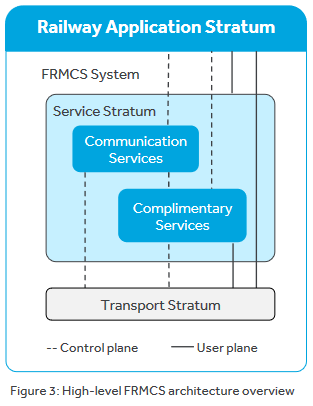
The 5G Rail project, led by an industrial consortium of 18 rail and telecom partners across 11 countries, aims to validate FRCMS V1 for the railway sector. Led by UIC as coordinator and technical authority, it began in November 2020 and will conclude in April 2023 with a total investment of 14 million euros.
UIC, along with European Commission Directorate-General for Digital Technology (DG Connect), formed the 5G Rail consortium, bringing together railway operators (German Rail-DB, French National Railways–SNCF, Swiss Federal Railways–SBB, Austrian Federal Railways–ÖBB, and Infrastructures de Portugal-IP) and telecom industry players (Nokia, Kotron, Alstom, Thales, Siemens, CAF, Teleste, and European Rail Industry– UNIFE), to work on prototyping the FRMCS system, simulation, and field test phases in France and Germany. A 5G Rail Advisory Board has been set up to involve as many rail sector stakeholders as possible. The first members to join the committee are Network Rail, RFI, ADIF, Infrabel, Trafikverket, SZ, Rail Baltica, Shift2Rail, European Railway Agency (ERA), UNISIG, ETSI TCRT, with many others set to request membership soon.
The FRMCS ecosystem relies on a new onboard telecom system called the TOBA (Telecom On-Board Architecture) Box. TOBA offers a single harmonized system of groundto-train communications, where a number of different physical communications interfaces coexist within the locomotive for voiceactivated GSM-R applications and ETCS signaling. TOBA will act as a “hub” for the “digital railway” within the train, taking charge of all incoming and outgoing telecommunications and supplying sufficient bandwidth and Quality of Service (QOS) for all future onboard applications with frequencyhopping, cybersecurity functions, and other features.
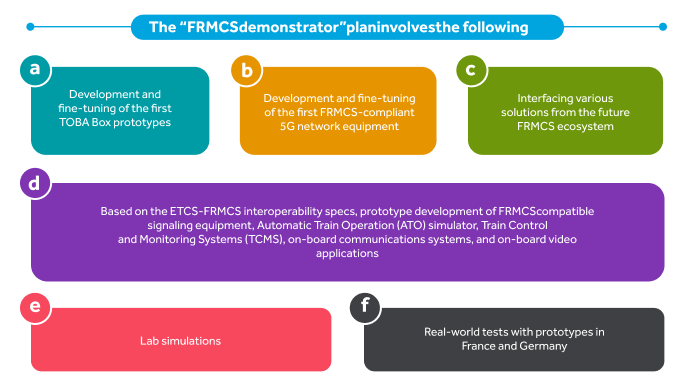
• Current status
- UIC has delivered the user requirements specification after consulting its stakeholders
- There is an ongoing evaluation to assess FRMCS compatibility with 3GPP releases
• Next steps
- Finalize the technical specifications and architecture of FRMCS
- Address how the railway-specific applications will be developed and tested
- Develop and test FRMCS
• Next steps
- Specify how to handle backward compatibility to GSM-R and ensure business continuity
- Define the on-board solution, a prerequisite/important parameter for a successful migration
- Define the rules of the game for an IM to be able to close down its GSM-R network in favor of FRMCS
• Current status
- ETSI is currently building a spectrum requirements document to be presented to frequency management organizations. This step is essential to get the appropriate spectrum for the future system
• Next steps
- Continue the process to ensure that IMs have access to the required spectrum to ensure a smooth migration and reuse of their existing infrastructure
• Next steps
- Specify how FRMCS prototyping and development will be financed
- Develop a business case at the European level to support the migration from GSM-R to FRMCS
- Specify the legal framework of the new telecom environment (including which part of FRMCS should be part of TSI CCS)
.jpg)
(a) Passenger Information System (PIS): Digital signage, Wi-Fi connectivity, infotainment
On board the moving train, the following services using near-real-time information can be provided as part of the PIS:
• 3D wayfinding, event details, points of interest, and emergency information
• Travelers can also connect directly to station or operation officials and talk to a live person on the screen
• In railway stations with lower-cost broadband or underdeveloped/unavailable internet infrastructure, free public Wi-Fi kiosks can help stations bridge the digital divide
(b) Connectivity and network communications: 5G technology is a step-change in mobile networking for both consumers and industry, offering users fast download speeds, low latency, and data sharing in near-real time, thereby allowing for radical advancements in connectivity on board moving trains. For example, downloading a 2-gigabyte high-definition movie in less than 20 seconds on a phone is now becoming a reality for train passengers. Railways with 5G infrastructure can offer 5G Wi-Fi to passengers on board. To improve passenger experience, train operators are looking to expand the reliability and availability of on-board WiFi, enabled by super-fast and on-board broadband powered by 5G technology. In addition, when access to 5G is not possible (due to white zones, tunnels, etc.), on-board servers can maintain services, thanks to their new edge computing performance.
(c) Infotainment and Advertisement: Digital signage on board trains and within train stations can improve passenger experience and safety, shorten queues, optimize people flow and wayfinding, and improve labor efficiency and passenger experience. High-performance, environment-sensing display technology allows advertisers, retailers, and station operators to effectively monetize visual communications, engage passengers, and boost commercial revenue on board moving trains. Optimized near-real-time displays improve customer experience by providing information, entertainment, and wayfinding support. Modern digital infrastructure at the network edge helps deliver actionable, data-driven insights and support for applications and experiences for passengers on board the train.
.jpg)
(d) Smart ticketing and contactless journey through automated fare collection, access control, and touchless retail transactions on-board: Smart ticketing systems, part of the contactless journey, can be applied to rail transit and utilized on board moving trains. Passengers can use stored value cards that can be quickly charged through the gate at stations or on board, with the validator deducting fare from the contactless card automatically. The e-ticketing system can greatly improve the quality of intelligent traffic and transport efficiency by automating the entire ticketing management process for a railway. Smart ticketing systems allow for fare collection to occur through a credit card tap while on board the moving train, via a railcard on the train, or through a smartphone. The use of sensor beacons could eventually result in the removal of ticket barriers and signal an end to queues at the ticket machine in metro railway stations. Sensors on station platforms or onboard trains will be able to detect an app on passenger smartphones as they enter the station or board, automatically charging the correct fare and eliminating overcharges. Metro railway operators will be able to streamline backend billing and revenue management while better understanding metro train usage behavior through near-real-time data.
(e) Access control: With access control using biometric e-gates, passengers could board their train without a ticket or passport. With a simple glance at a high-resolution camera, the passenger's biometric ID would be recognized in a matter of seconds. The image would be securely sent to customers and border control for traveler verification, which would then match the data with the stored digital token captured during the initial immigration process. In a few seconds, the system would reconcile the passenger with the train, recognize the passenger as eligible to enter the train, and accordingly open the e-gate for the passenger to board. Digital passport technology will allow passengers to complete customs from on board the train prior to arrival in the country they are visiting. Digital signage and kiosks can display near-real-time public safety messages to warn travelers about evacuations, toxic gasses, or other emergencies. Railway station officials can use on-board cameras to measure and analyze passenger flow, improving railway safety and traveler experience.
.jpg)
(f) Passenger safety: Smart security functions can also enhance passenger safety and reduce public liability. For example, computer vision solutions can enable automated and safe platform screen door systems and train door systems on passenger trains and detect when passengers slip and fall. In addition, these solutions can help locate missing children in a crowd and can detect if children climb onto conveyor belts, fall on escalators or onto trackways, or enter restricted areas. The need for automated quarantine control can also be identified, as well as potential water spills and smoke and fire detection. This service remains available and effective, regardless of any disconnection from the Internet or the cloud.
.jpg)
(g) Predictive maintenance: Predictive maintenance for tracks, locomotives, trains, and equipment is an important safety and efficiency tool for railway operators. It uses near-real-time diagnostic data to plan maintenance cycles at an early stage through monitoring and the collection of data, helping railway operators to avoid operational breakdowns or failures. Downtimes and maintenance costs are reduced while the life of tracks, locomotives, trains, and equipment increases. Passengers, in turn, benefit from improved reliability of railway operations.
(h) Driver assistance/operator distraction prevention: The natural demands of long-distance trips can leave railway operators fatigued and distracted, creating the potential for increased errors. It can be challenging for railway organizations to track the sleep patterns, energy levels, and/or behavior of drivers and operators. With the implementation of a computer vision AI-based solution, railways can use predictive analytics to detect face and eye signals that may indicate possible distraction and fatigue. These tools can help drivers, operators, and railway managers increase safety, prevent accidents, and protect assets. Detection of potential obstacles on railways is also critical. Automatic, near-real-time warnings require high performance and online video analysis so as to efficiently provide monitoring to the driver or to the automatic driving system.
(i) People counting: Getting from one place to another in a train station can create challenges for customers and train station stakeholders on a daily basis. Congestion, overcrowding, and the potential for crime can result in lost revenue and operational inefficiencies for stations, apart from traveler dissatisfaction. Using deep learning and AI through computer vision, stations can accurately monitor passenger traffic flow for enhanced analytics that aid in decision-making for station planning and operations. This includes assigning the right quantity of staff during traffic spikes and protecting people and assets by detecting potential issues before they happen.
(j) Cargo tracking: A constant challenge for travelers is the way their cargo is handled. If the cargo of a passenger is transferred to the wrong connecting train, it can be costly and detrimental to the reputation of the company. An operator using computer vision can track passengers’ cargo and notify other operators if the cargo is misplaced, helping to ensure on-time delivery to the correct destination.
(k) Asset tracking: For safety and efficiency, it is important for railways to know where their assets are at all times. With so many different assets constantly on the move, railways face challenges, including delays, lost equipment, theft, and errors. Leveraging asset tracking through computer vision can reduce the dwell time of stationary locomotives, increase operational efficiency, and can track all of a railway system’s assets in near-real-time to maximize utilization and reduce cost.
(l) Enhancing security: Enhanced security at the platform level and improved security of data and communications are essential to ensuring success within railway systems. In this case, vision applications help railways enhance security, measure the flow of people, enable smart parking at stations, and provide automated access control. Railway operators can use optical sensing, thermal detection, alarm systems, and system linkage to protect the perimeter. Track monitoring identifies arriving and departing trains with optical sensing, thermal detection, long-range viewing, and panoramic mode. Parking lot security helps protect parking lots and control entrances using license plate recognition, optical sensing, and parking guidance. Railway operators can also control traffic and monitor vehicles using optical sensing, license plate recognition, suspect car alarm, information issuing, and traffic incident detection. Terminal monitoring allows railway operators to monitor retail sites, passenger behavior, e-passport gates, and luggage systems. Smart security at train stations and on board trains can use biometric indicators to confirm identity as well as provide alerts about people of interest or suspects in a crowd in an uncontrolled environment or for abandoned bag detection. Alerts for any overcrowding incidents with people-counting based on zones can enhance rescue operations during emergencies. Trolleys that have been left where they should not be, as well as suspicious behaviors such as loitering, sudden crowd gathering, or man-down problems, are also detectable. With individual privacy as a fundamental concern, all biometric and personally identifiable data are fully anonymized at the source. Stored and transmitted data are encrypted using state-of-the-art algorithms powered by on-board hardware accelerators.
.jpg)
Harmonized frequency bands for FRMCS are now under standardization in 3GPP as 5G bands which is a base to enable a sustainable ecosystem of chipsets for mobile devices. With an advanced capability of bearer flexibility, different bands, such as satellite or mobile network operator sharing models, can be considered as options to define successive business models. FRMCS is developed as an IP-based technology towards the adoption of modernized transmission network functionality. One of the fundamental specs of the 3GPP 5G standard is to have virtualized, software- and cloud-enabled networks that can support such an evolution while benefiting from IT-based technology and migration of GSM-R and 5G-compatible products. The railway domain can greatly benefit from synergies with other industry domains with respect to enabling missioncritical networks and applications. The 3GPPdefined Mission Critical Communication standards will allow for synergies in products and solutions based on solid standards.
.jpg)
Original equipment manufacturers (OEMs) are under relentless pressure to accelerate product design and development, extend equipment life cycles, improve product performance, and develop localized products for different market needs all while keeping their production costs competitive. Cyient’s end-to-end heavy equipment and industrial product design engineering services helps your organization remain competitive, deliver new product innovation, and maintain asset health using IoT and predictive analytics.
Cyient supports OEMs in developing cutting-edge industrial equipment, including industrial tools, controllers, process and power distribution equipment leveraging our extensive knowledge in heavy equipment design and industrial product design engineering services. Designed for both equipment manufacturers and operators, our ready-to-deploy solution frameworks, for heavy equipment, material handling equipment, industrial products and industrial machinery, span the entire product life cycle-development, optimization, localization, value analysis and value engineering, design-to-build, and aftermarket services.
We can support all aspects of design and manufacturing, offering system engineering for the design, build, and maintenance aspects of the product life cycle. Our capabilities include:
We are now in a phase where the definition, development, and eventual deployment of FRMCS is underway. Some of the use cases— automatic rail operations, advanced detection system, 360-degree access and facilities for rail passenger systems, smart railway platforms and maintenance, proactive management, etc. can be successful implementations for rail networks. Horizon 2020 5GRAIL is an EU-funded project to support first market application and a pilot project to introduce the 5G based FRMCS technology. The project consists of eight work packages which help to validate FRMCS specifications by developing and testing prototypes for the FRMCS ecosystem for trackside infrastructure and on-board use in both laboratory and real track conditions.
Digitalization and automation in rail networks will remain a business driver for the deployment of both FRMCS and broadband applications far beyond today’s GSM-R networks. This will benefit railways as an enterprise and its passengers under the B2C market segment. Rail and network operators will have to agree on a strategy to introduce network and network applications, migrating to newer networks to ensure a stable and healthy business environment for all stakeholders to meet the market requirements for FRMCS. FRMCS is set to become a global standard that will revolutionize railway communications. This mobile broadband-ready technology will enable railways with improved safety and operational efficiency while supporting innovative passenger services and accelerating 360-degree digital transformation which will help rail commuters. FRMCS also minimizes network latency and makes use of cloud technology which will help automate train operations and support broadband M2M communication.
.jpg)
.jpg?width=255&height=255&name=ralway-communication-images%20(2).jpg)
Ajay Kumar Lohany, Aeronautical Engineer
Ajay Kumar Lohany is an aeronautical engineer with specialization in avionics systems. He holds a master’s degree in computer science and modeling and simulation. He has served in the Indian Air Force as a flight test and instrumentation engineer, with over 32 years of industry experience. He takes keen interest in building technological solutions that help solve problems in the aerospace and rail domains.
Cyient (Estd: 1991, NSE: CYIENT) is a global Engineering and Technology solutions company. We collaborate with our customers to design digital enterprises, build intelligent products and platforms and solve sustainability challenges. We are committed to designing tomorrow together with our stakeholders and being a culturally inclusive, socially responsible, and environmentally sustainable organization.
For more information, please visit www.cyient.com
Cyient (Estd: 1991, NSE: CYIENT)delivers Intelligent Engineering solutions for Digital, Autonomous and Sustainable Future
© Cyient 2024. All Rights Reserved.